ESP AUDI A8 2016 Manual PDF
[x] Cancel search | Manufacturer: AUDI, Model Year: 2016, Model line: A8, Model: AUDI A8 2016Pages: 302, PDF Size: 75.68 MB
Page 215 of 302

fill up at busy gas st ations where the season al
adjustment is more likely to be made in time .
(D Note
-Me thanol f uels which do not mee t these re
quirements may ca use corros ion and dam
age to plastic and rubber components in the
fuel system .
- Do not use fuels that fai l to meet the speci
fied criter ia in this chapter.
- If you are unable to determine whether or not a particular fuel blend meets the speci
ficat ions, ask your service station or its fuel
supplier.
- Do not use fuel for which the contents can
not be identif ied.
- Fuel system damage and performance prob
lems resulting from the use of fue ls differ
ent from those specified are not the respon
s ibility of Audi and are not covered under
the New Veh icle or the Emiss ion Control
System Wa rrant ies.
- If you experience a loss of fue l economy or
driveability and performance prob lems due
to the use of one of these fuel b lends, we
recommend that you switch to unblended
fuel.
Gasoline additives
Applies to: vehicles with gasol ine engine
A majo r concern among many au to manufactur
ers is carbon deposit build- up caused by the type
of gasoline yo u use.
A lthough gasoline grades d iffer from one manu
f a cturer to ano ther, they have cer tain things in
common . A ll gasoline grades contain substances
that can cause deposits to collect on vita l engine
pa rts, such as fue l injectors and intake valves . Al
though most gaso line brands include additives to
keep engine and fuel systems clean, they are not
equally effective.
Aud i recommends using TOP TIER Detergent Gas
oline. For more informat ion on TOP TIER Deter
gent Gasoline, please go to the official website (www.toptiergas .com) .
Fuel and R efueling
After an extended period o f using inadeq uate
fuels, carbon deposit bui ld-ups can rob your en
gine o f peak performance.
(D Note
Damage or ma lf u nction due to poo r fue l qual
ity is not covered by the A udi New Vehicle
Limited Warranty .
Diesel fuel
Applies to: vehicles with diesel engine
Always use ULSD (Ultra Low Sulfur Diesel) No. 2 .
The ULSD No . 2 meets the ASTM 0975.
Diesel f uel w it h concen tratio ns of b iod iesel h igh
er than 5 % such as Bl 1, B20 or BlOO are strict ly
prohibited .
Se rvice station fuel p umps are labe led with the
correct f uel i nfo rmat ion for e asy recog nition by
the user.
If the d iesel f ue l pump is no t labeled
ask the station operator what fuel is being dis
pensed before fil ling up your vehicle .
UL SD No . 2 m ay not be available ou tside the USA
and Canada . Be su re to check befo re t raveling to
other countries .
UL SD No . 2 c an become thic ke r i n ve ry cold tem
peratures, and this can imp air the engine's s tart
ing and running. Depend ing on the sea son, gas
stations provide ULSD No . 2 that flows better in
cold temperatures so that you can continue oper
at ing your vehicle as usual.
@ Note
- Your vehicle's diese l engine was designed
sole ly for use with ULSD No . 2 . Therefo re,
neve r use gasoline, heating oil, other fuels
or flow improvers. These contain substances
that will severely damage the fuel system
and the engine . Such damage will not be
cove red by your New Vehicle Limited War-
r a nty.
- If you put a ny amo unt of incorrect fuel in
the fuel tank, do not sta rt the eng ine under
any circumstances. Imme diately contact the
II>-
213
Page 217 of 302
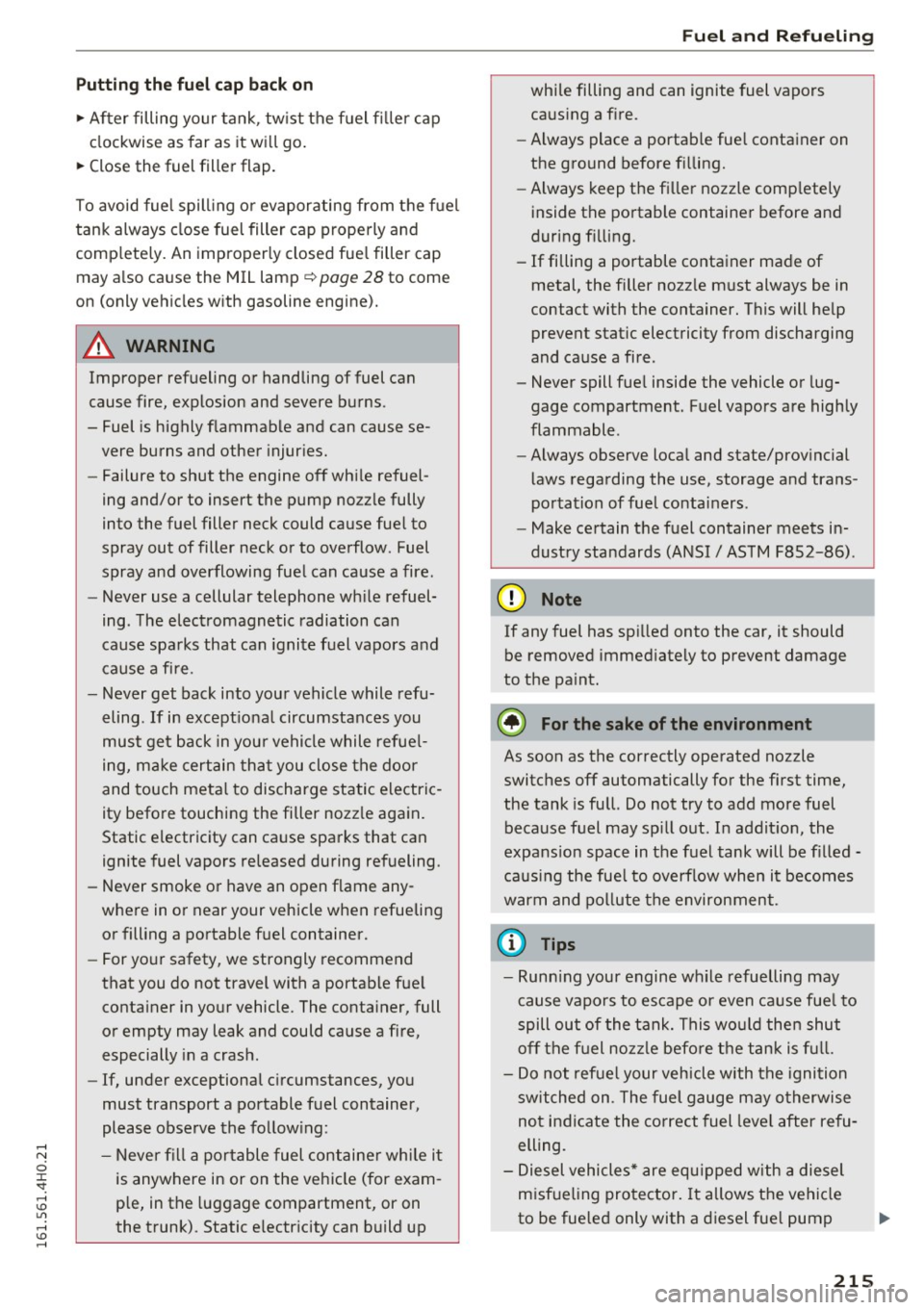
Putting the fuel c ap back on
"' After filling your tank , tw ist the f uel fi ller cap
clockwise as far as it wi ll go .
"' Close the fuel filler flap.
To avoid fuel spill ing o r evaporating from the f uel
tank always close fuel filler cap properly and
comp let ely. An improperly closed fue l filler cap
may a lso caus e the MIL lamp ¢
page 28 to come
on (only vehicles with gasoline engine).
A WARNING
Improper refueling or handling of fuel can
cause fire, explosion and severe burns .
- Fuel is highly f lammable and can cause se
vere burns and other injur ies.
-
- Failure to shut the engine off wh ile refuel
ing and/or to insert the pump no zzle fully
into the fuel filler neck could cause fuel to
spray out of filler neck or to overflow . Fuel
spray and overflowing fue l can cause a fire .
- Never use a cellular telephone wh ile refuel
ing . The electromagnetic radiation can
cause spa rks that can ignite fuel vapors and
cause a fire.
- Never get back into your vehicle while refu
eling .
If in except io na l circumstances you
must get back in you r vehicle while refue l
ing, make certain tha t you close the door
and touch meta l to discharge static electric
ity before touchi ng the filler nozz le again.
Static electricity can ca use spa rks that can
ignite fuel vapors released during refueling .
- Never smoke o r have an open flame any
where in or near your vehicle when refueling or filling a portable f uel container.
- For yo ur safety , we strongly recommend
that you do not travel with a portable fue l
conta iner in your vehicle. The conta iner, full
or empty may leak and could cause a fire,
especially in a crash .
-If, under exceptional c ircumstances, you
must transport a portable fuel container,
please observe the follow ing :
- Neve r fi ll a portable fuel containe r wh ile i t
is anywhere in or on the vehicle (for exam
p le, in the luggage compartment, or on
the trunk) . Static e lectr icity can build up
Fuel and R efueling
whi le filling and can ignite fuel vapors
caus ing a fire .
- Always place a portab le fue l container on
the ground before f illing.
- Always keep the fi ller nozzle comp lete ly
inside the po rtable container before and
during f illing.
- If filling a portable container made of
metal, the filler nozz le m ust always be in
contact with the container. This will he lp
prevent stat ic electricity from discharging
and cause a fire .
- Never spill fue l inside the vehicle or lug
gage compartment. F uel vapors are highly
flammable .
- Always observe local and state/prov incial
laws regarding the use, storage and trans
po rtation of fuel co nta iners.
- Make ce rtain t he f uel container meets in
dust ry standards (ANSI/ ASTM F852-86) .
(0 Note
If any fuel has sp illed onto the car, it should
be removed immed iately to p revent damage
to the pa int.
@ For the sake of the environment
As soon as the correctly operated noz zle
switches off automatically for the first time,
the tank is fu ll. Do not try to add more fuel
because f uel may sp ill out . In add it ion, the
expans ion space in the fuel tank will be fi lled -
causing the fue l to overflow when it becomes
warm and po llute the environment.
(D Tips
- Runn ing your engine while refuelling may
cause vapors to escape or even ca use fue l to
spill out of the tank. This wo uld then shut
off the f uel no zzle befo re t he t ank is f ull.
- Do not ref ue l your veh icle with the ignition
switched on . The fuel gauge m ay o therwise
no t indicate the co rrect fuel leve l after refu
elling.
- Diesel vehicles* are equ ipped wi th a die sel
m isf ueli ng pro tector . It a llows the vehi cle
to be fuele d only with a d iesel fue l pump .,.
215
Page 222 of 302
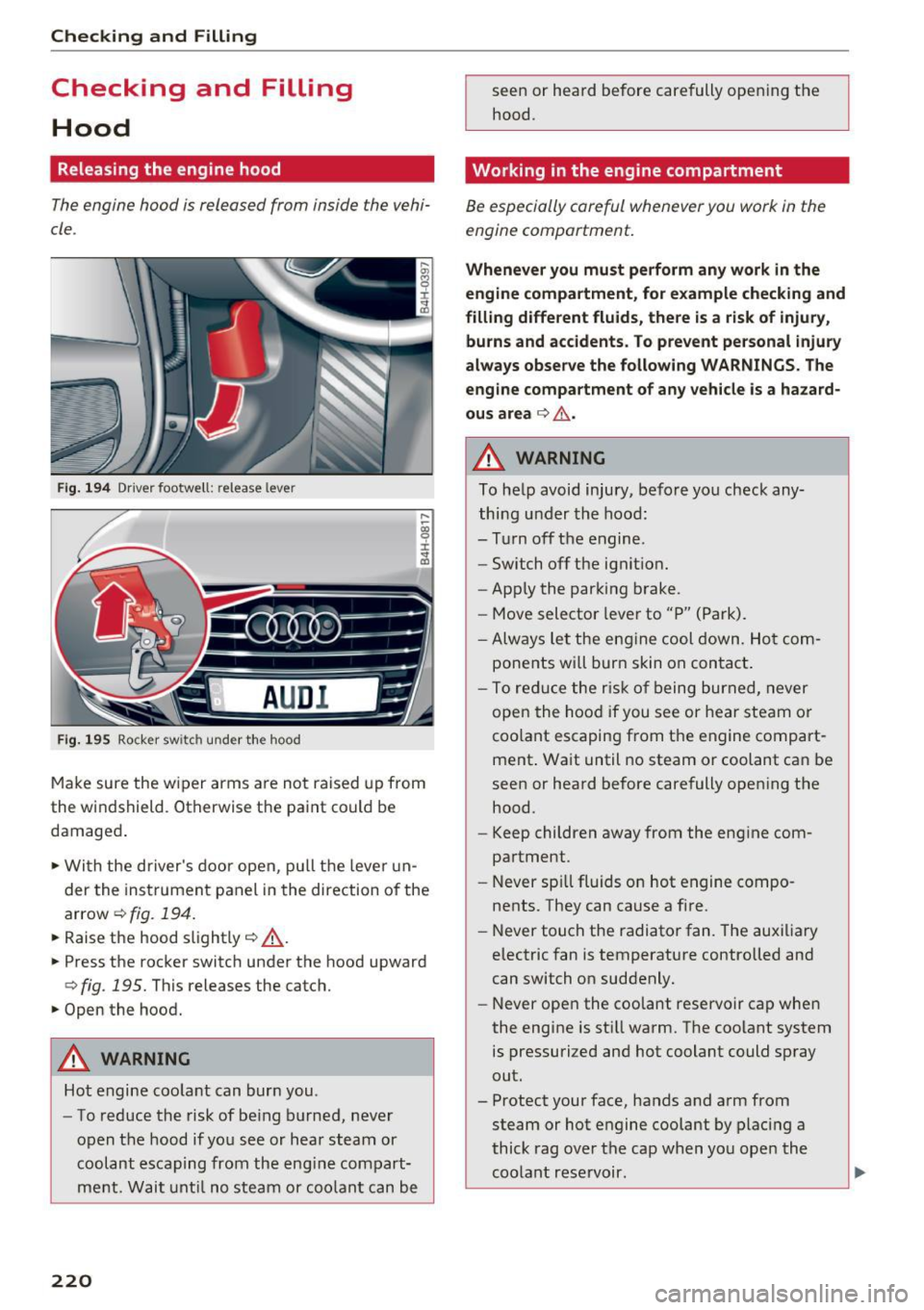
Checking and Filling
Checking and Filling
Hood
Releasing the engine hood
The engine hood is released from inside the vehi
cle .
Fig. 194 Driver footwell : release leve r
Fig. 195 Ro cker switc h under the hood
Make sure the wiper arms are not raised up from
the windshield . Otherwise the paint could be
damaged .
.. With the driver's door open, pu ll the lever un
der the instrument panel in the direction of the
arrow ¢
fig. 194.
.. Raise the hood slightly Q _A .
.. Press the rocker switch under the hood upward
Q fig. 195. This releases the catch.
.. Open the hood.
A WARNING
Hot engine coo lant can burn you .
- To reduce the risk of be ing burned, never
open the hood if you see or hear steam or
coolant escaping from the eng ine compart
ment. Wait unt il no steam or coolant can be
220
seen or heard before carefully open ing the
hood.
Working in the engine compartment
Be especially careful whenever you work in the
engine comportment.
Whenev er yo u mu st perform an y work in the
engin e compartment , for exampl e chec king and
filli ng d iffe rent fl uids , the re is a ri sk of injur y,
bu rn s and accid ent s. T o preven t perso na l injur y
alway s obse rve the foll owing WARNING S. The
en gine compartment o f an y v ehicl e is a haz ard
ou s a rea
Q _6 .
A WARNING
To help avoid injury, before you check any
thing under the hood:
- Turn off the engine .
- Switch off the ignit ion.
- Apply the parking brake.
- Move selector lever to "P" (Park).
-Always let the eng ine cool down. Hot com-
ponents will burn skin on contact .
-
-To redu ce the risk of being burned, never
open the hood if you see or hear steam or
coo lant escaping from the engine compart
ment . Wait until no steam or coolant can be
seen or heard before carefully opening the
hood.
- Keep children away from the engine com
partment .
- Never sp ill fluids on hot engine compo
nents. They can cause a fire.
- Never touch the radiator fan. The auxiliary
electric fan is temperature controlled and
can switch on suddenly.
- Never open the coolant reservoir cap when
the engine is sti ll warm. The coolant system
is pressurized and hot coolant could spray
out.
- Protect your face, hands and arm from
steam or hot engine coolant by placing a
thick rag over the cap when you open the
coolant reservoir .
Page 229 of 302
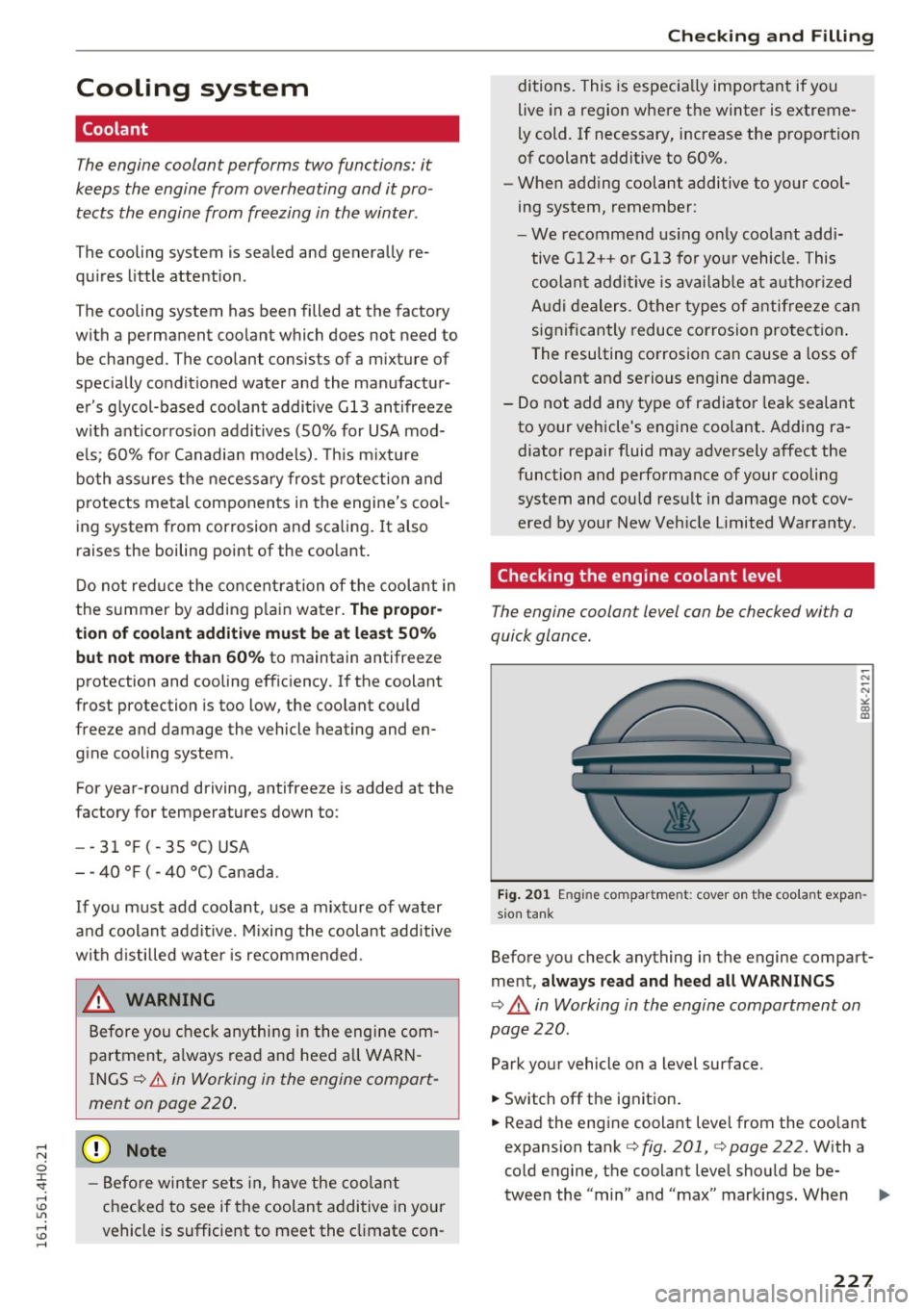
Cooling system
Coolant
The engine coolant performs two functions: it
keeps the engine from overheating and it pro
tects the engine from freezing in the winter .
The cooling system is sealed and generally re
quires little attention.
T he cooling system has been filled at the factory
with a permanent coolant which does not need to
be changed . The coolant consists of a mixture of
specially condit ioned water and the manufactur
er's glycol-based coolant additive Gl3 antifreeze
with anticorrosion additives (SO% for USA mod
e ls; 60% for Canadian mode ls). This m ixture
both ass ures the necessa ry frost protection and
protects metal components in the engine's coo l
ing system from corrosion and scaling .
It also
raises the boiling point of the coolant.
Do not red uce the concent ration of the coolant in
the summer by adding p lain water.
The propor
tion of coolant addit ive mu st be at least 50 %
but not more than 60 %
to mainta in antifreeze
protection and cooling efficiency. If the coolant
frost protection is too low, the coolant could
freeze and damage the vehicle heating and en
g ine cooling system .
For year-round driving, antifree ze is added at the
factory for temperatures down to :
- -31° F(- 3S°C)USA
- - 40 ° F ( - 40 °C) Canada.
If you must add coolant, use a m ixture of water
and coolant addit ive. M ixing the coolant additive
with d istilled water is recommended .
_& WARNING
Before you check anythi ng i n t he engine com
partment, always read and heed all WARN
INGS
¢ .&. in Working in the engine compart
ment on page 220 .
(D Note
-Befo re winter se ts in, have the coo lant
checked to see if the coolant additive in your
vehicle is sufficient to meet the cl imate con -
Check ing and Filling
ditions. This is especially important if you
live in a region where the winter is extreme
ly cold. If necessary, increase the proportion
of coolant additive to 60%.
- When adding coolant additive to your cool
ing system, remember :
- We recommend us ing only coolant add i
tive Gl2+ + or Gl3 for yo ur vehicle. This
coolant addit ive is avai lab le at aut horized
A udi dealers . O ther types of antifree ze can
significantly reduce corrosion pro tect ion .
The resulting corrosion can cause a loss of
coolant and serious engine damage.
- Do not add any type of radiator leak sealant
to your vehicle's engine coolant. Adding ra
diator repair fluid may adversely affect the
function and performance of your cooling system and cou ld resu lt in damage not cov
ered by your New Veh icle Limited Warra nty .
Checking the engine coolant level
The engine coolant level can be checked with a
quick glance.
Fi g. 2 01 Engin e compar tmen t: cover o n th e coo lant expan
sion t ank
Before you check anything in the engine compart
ment,
always read and heed all WARNINGS
¢ A in Working in the engine compartment on
page 220 .
Park your vehicle on a level surface .
.,. Switch off the ignition .
.,. Read the engine coolant level from the coo lant
expansion tank
¢ fig . 201, ¢page 222. With a
cold engine, the coolant level should be be-
tween the "min" and "max" markings. When .,.
227
Page 233 of 302
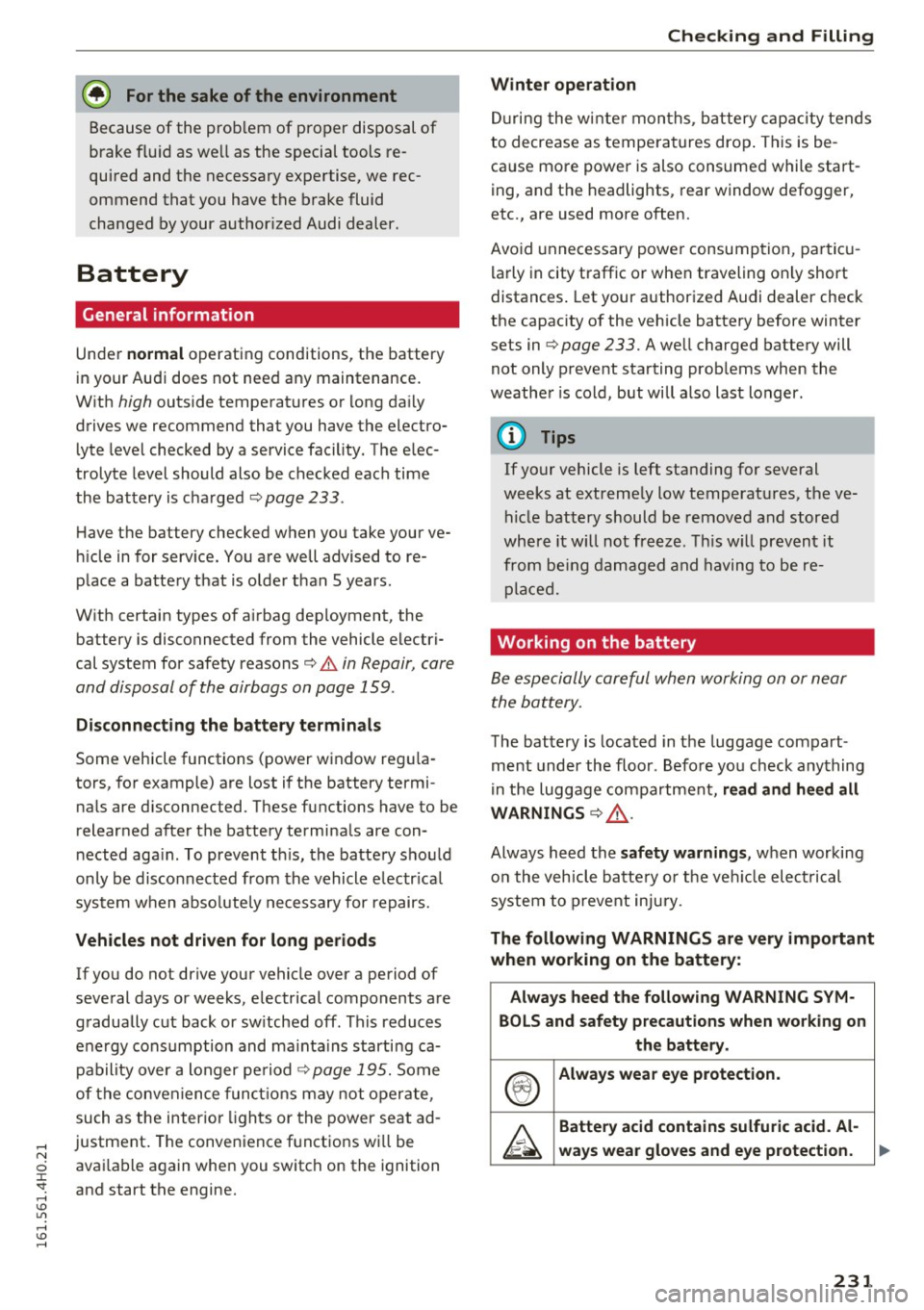
@ For the sake of the environment
Because of the problem of proper disposal of
brake fluid as we ll as the special toots re
quired and the necessary expertise, we rec
ommend that you have the brake fluid
changed by your authorized Audi dealer .
Battery
General information
Under normal operating conditions, the battery
in your Audi does not need any maint enance.
With
high outside temperatures or long daily
drives we recommend tha t you have the electro
lyte level checked by a service facility. The elec
trolyte level should also be checked each time
the battery is charged ¢
page 233.
Have the battery checked when you take your ve
hicle in for serv ice. You are well advised to re
place a battery that is older than 5 years .
With certain types of airbag deployment, the batte ry is disconnected from the vehicle electri
cal system for safety reasons¢
& in Repair, care
and disposal of the airbags on page 159 .
Disconnecting the battery terminals
Some vehicle functions (power window regu la
tors, for example) are lost if the battery te rmi
nals are disconnected. These functions have to be
relearned after the battery terminals are con
nected again. To prevent th is, the battery should
only be disconnected from the vehicle e lectr ica l
system when abso lutely necessary for repairs.
Vehicles not driven for long periods
If you do not drive your vehicle over a period of
several days or weeks, electrical components are
gradually cut back or sw itched off. This reduces
ene rgy consumption and ma inta ins starting ca
pability over a longer period ¢
page 195. Some
of the convenience functions may not operate,
such as the interior lights or the power seat ad
justment. The convenience funct ions will be
ava ilable again when you switch on the ignition
and start the engine.
Checking and Filling
Winter operation
During the winter months, battery capacity tends
to decrease as temperatures drop . This is be
cause more power is also consumed while start
ing, and the headlights, rear window defogger,
etc., are used more often.
Avo id unnecessary power consumption, particu
larly in city traffic or when traveling only short
distances . Let your authorized Audi dealer check
the capacity of the vehicle battery before winter
sets in ¢
page 233. A well charged battery will
not only prevent starting problems when the
weather is cold, but will also last longer .
(D Tips
If your vehicle is left standing for several
weeks at extremely low temperatures, the ve
hicle battery should be removed and stored
where it w ill not freeze . This will prevent it
from be ing damaged and having to be re
placed.
Working on the battery
Be especially careful when working on or near
the battery.
The battery is located in the luggage compart
ment under the floor . Before you check anything
in the luggage compartment,
read and heed all
WARNINGS ¢
&-
Always heed the safety warnings, when working
on the vehicle battery or the veh icle electrical
system to prevent injury.
The following WARNINGS are very important
when working on the battery:
Always heed the following WARNING SYM·
BOLS and safety precautions when working on
the battery.
®
Always wear eye protection.
~
Battery acid contains sulfuric acid. Al-
ways wear gloves and eye protection.
231
Page 236 of 302
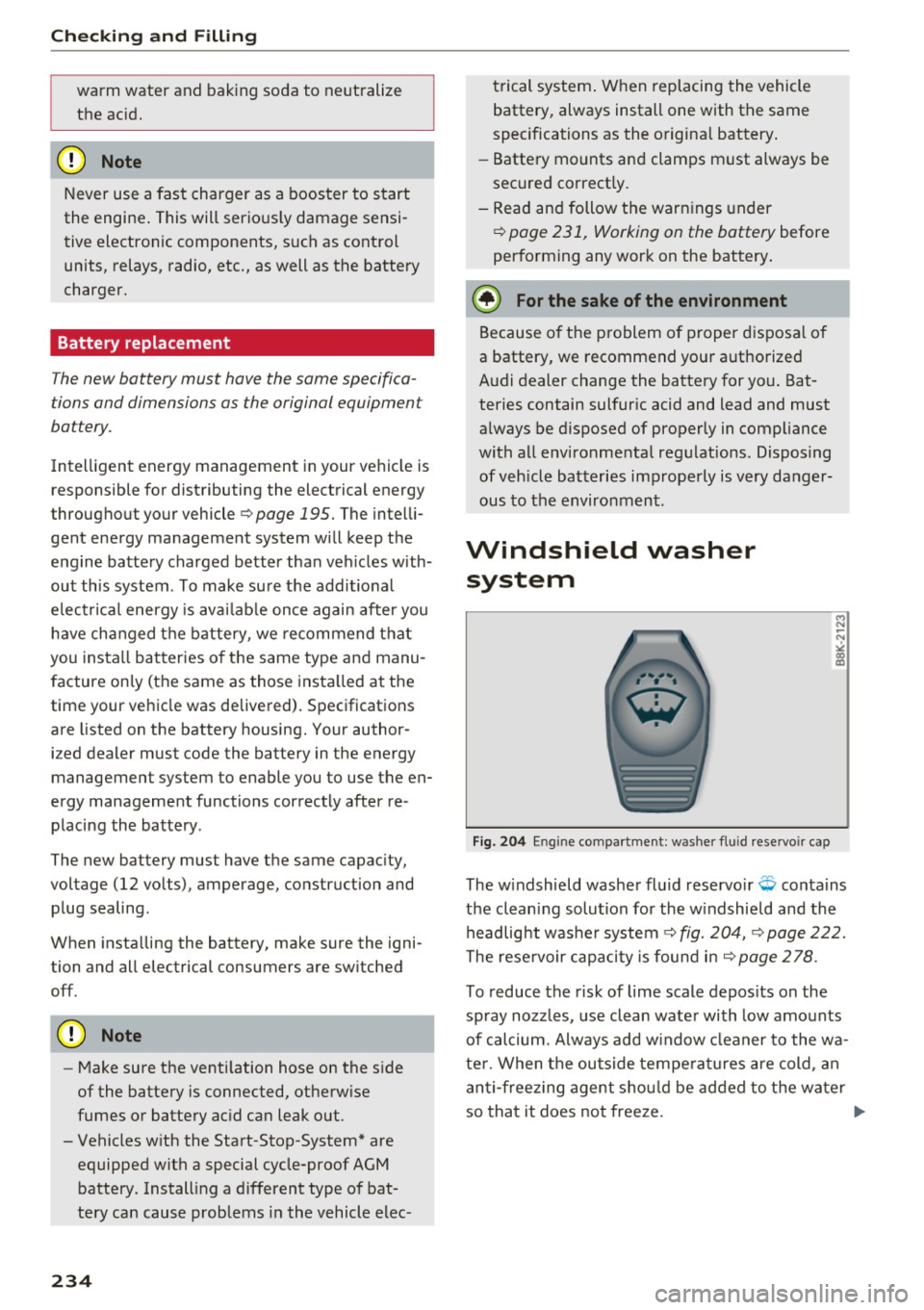
Check ing and F illing
warm water and baking soda to neutralize
the acid.
CD Note
Never use a fast charger as a booster to start
the engine . This will serious ly damage sensi
tive electronic components, such as control
units, relays, radio, etc., as well as the battery
charger.
Battery replacement
T he new battery must have the same specifica
t ions and dimensions as the original equipmen t
bat tery.
Int elli g ent en ergy managem ent in your vehicle is
responsible for distributing the electrical energy
throughout your vehicle
r=> page 195. The intelli
gent energy management system will keep the
engine battery charged better than veh icles w ith
out this system . To make sure the addit ional
e lectrical energy is avai lab le once again after you
have changed the battery, we recommend that
you install batteries of the same type and manu facture on ly (the same as those installed at the
time your vehicle was delivered). Specifications
are listed on the battery housing. Your author
i z ed dealer must code the battery in the energy
management system to enable you to use the en
ergy management functions correctly after re
placing the battery .
The new battery must have the same capacity,
voltage (12 volts) , amperage, construction and
plug sealing .
When installing the battery, make sure the igni
tion and all electrical consumers are sw itched
off.
CD Note
- Make sure the ventilation hose on the s ide
of the battery is connected, otherw ise
fumes or battery ac id can leak out.
- Vehicles with the Start-Stop-System* are equipped with a special cycle-proof AGM battery . Installing a d ifferent type of bat
tery can cause problems in the vehicle elec -
234
trical system. When replacing the vehicle
battery, always install one with the same
specifications as the original battery .
- Battery mounts and clamps m ust always be
secured correctly.
- Read and follow the warnings under
¢ page 231, Working on the battery before
performing any work on the battery .
@ For the sake of the environment
Because of the p roblem of proper disposal of
a battery, we recommend your authorized
A udi dealer change the battery for you . Bat
teries contain sulfur ic acid and lead and must
a lways be disposed of properly in compliance
with all environmental regulations . Disposing
of veh icle batteries improperly is very danger
ous to the environment .
Windshield washer
system
Fig. 204 En gin e compa rt ment: washer fluid rese rvoir cap
The w indshield washer fluid reservo ir Q conta ins
the cleaning solution for the w indshield and the
headlight washe r system ¢
fig. 204, ¢ page 222.
The reservoir capacity is found in
r=> page 2 78 .
To reduce the risk of lime scale depos its on the
spray nozzles, use clean water with low amounts
of calcium. Always add w indow cleaner to the wa
ter . When the outside temperat ures are cold , an
anti-freez ing agent shou ld be added to the water
so that it does not freeze. ..,.
Page 237 of 302
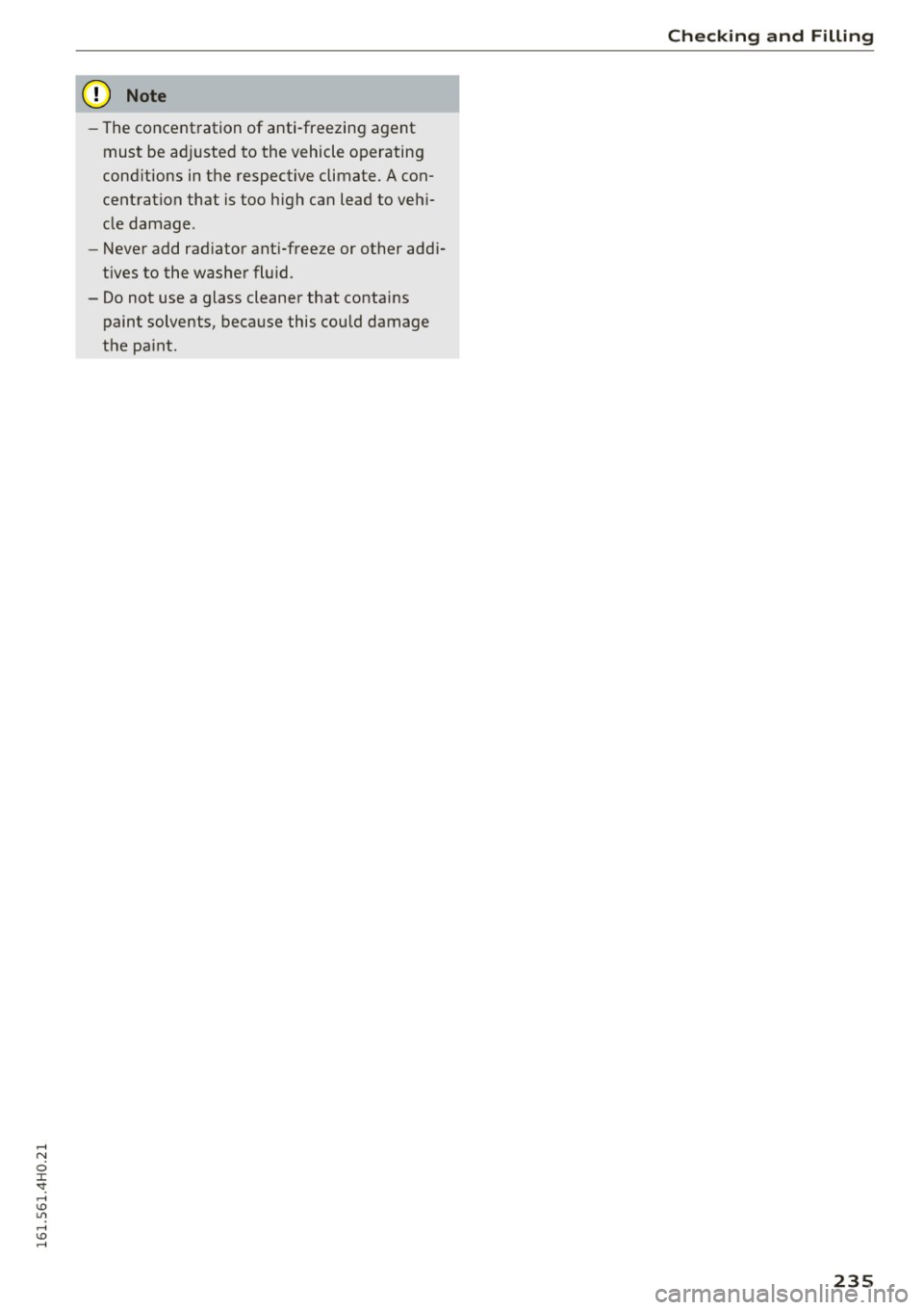
(D Note
-The concentration of anti-freezing agent
must be adjusted to the vehicle operating
conditions in the respective climate. A con
centration that is too high can lead to vehi
cle damage .
- Never add radiator anti-freeze or other addi
tives to the washer fluid .
- Do not use a glass cleaner that contains paint solvents, because this could damage
the paint.
Checking and Filling
235
Page 240 of 302
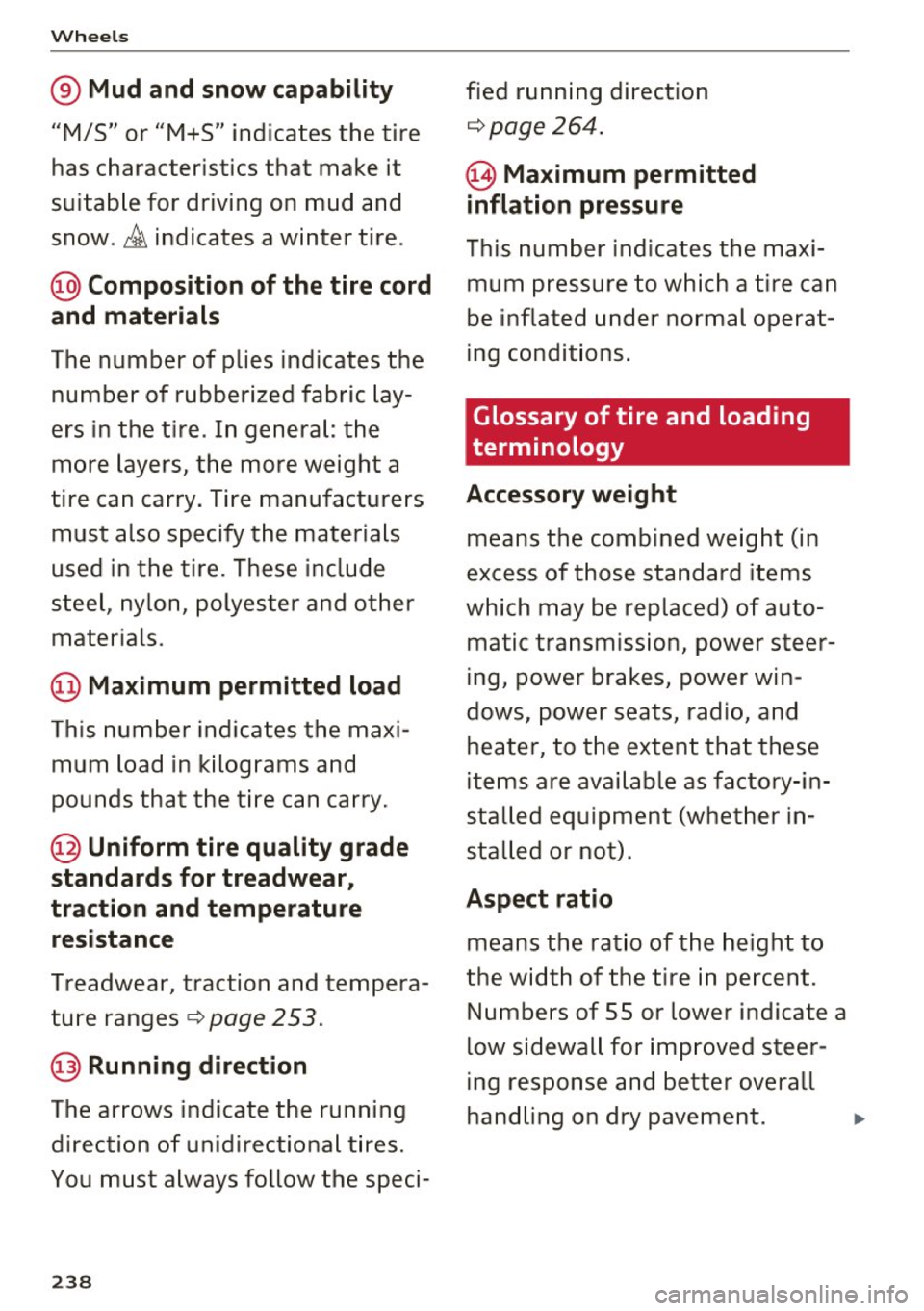
Wheel s
® Mud and snow capability
"M/5" or "M+S" indicates the tire
has characteristics that make it
suitab le for driving on mud and
snow. ~ indicates a winter tire.
@ Composition of the tire cord
and materials
The number of plies indicates the
number of rubberized fabric lay
ers in the tire . In general : the
more layers, the more weight a
tire can carry. Tire manufacturers
must also specify the materials
used in the tire. These include
steel, nylon, polyester and other materials.
@ Ma ximum permitted load
This number indicates the maxi
mum load in kilograms and
pounds that the tire can carry.
@ Uniform tire quality grade
standards for treadwear,
traction and temperature resistance
T readwear, traction and tempera
ture ranges ~
page 253.
@ Running direction
The arrows indicate the running
direction of unidirectional t ires.
You must always follow the speci-
238
fied running direction
~ page 264 .
(8) Maximum permitted
inflation pressure
This number indicates the maxi
mum pressure to which a tire can
be inflated under normal operat
ing condit ions.
Glossary of tire and loading
terminology
Accessory we ight
means the combined weight (in
excess of those standard items
which may be replaced) of auto matic transmission, power steer
ing, power brakes, power win
dows, power seats, radio, and
heater, to the extent that these
items are available as factory -in
stalled equipment (whether in
stalled or not).
Aspect rat io
means the rat io of the height to
the width of the tire in percent.
Numbers of 55 or lower indicate a
low sidewall for improved steer
ing response and better overa ll
handling on dry pavement.
Page 245 of 302
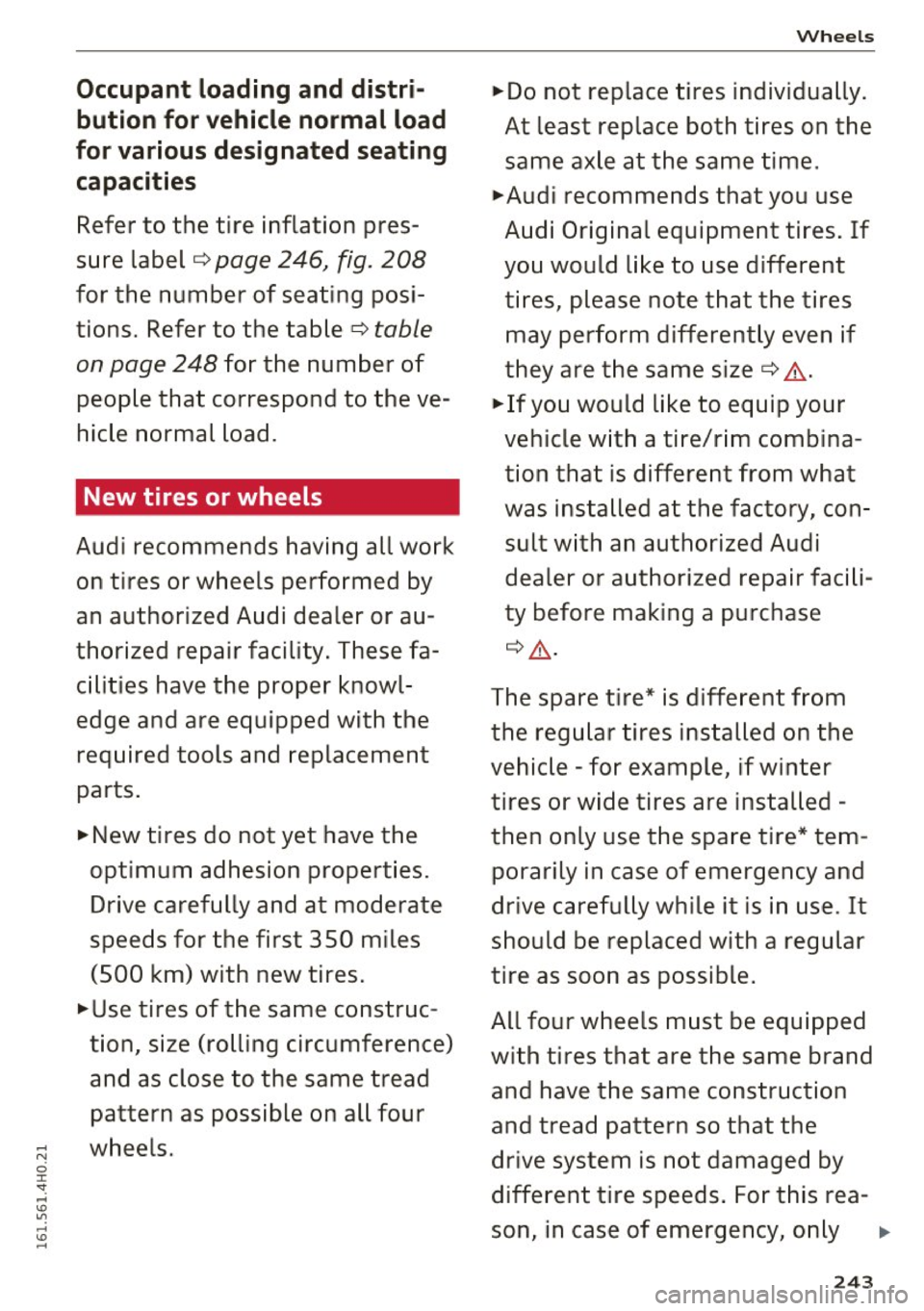
Occupant loading and distri
but ion for vehicle normal load
for various design ated se ating
c a pa cit ies
Refer to the tire inflation pres
sure label ¢
page 246, fig. 208
for the number of seating posi
tions. Refer to the table ¢
table
on page 248
for the number of
people that correspond to the ve
hicle normal load.
New tires or wheels
Audi recommends having all work
on tires or wheels performed by
an authorized Audi dealer or au
thorized repair facility. These fa
cilities have the proper knowl
edge and are equipped with the
required tools and replacement
parts .
.,,. New tires do not yet have the
opt imum adhesion properties.
Drive carefully and at moderate
speeds for the first 350 m iles
(500 km) with new tires .
... use tires of the same construc
tion, size (rolling circumference)
and as close to the same tread pattern as possible on all four
;:::; wheels.
ci :c ": ....
'° V, ....
'° ....
Wheels
.,,.Do not replace tires individually.
At least replace both tires on the same axle at the same time.
.,,. Audi recommends that you use
Audi Original equipment tires. If
you would like to use different
tires, please note that the tires may perform differently even if
they are the same size¢,&..
.,,. If you would like to equip your
vehicle w ith a tire/r im combina
tion that is different from what
was installed at the factory, con
sult w ith an authorized Audi
dealer or authorized repair facili
ty before making a purchase
~ .&. -
The spare tire* is diffe rent from
the regular tires installed on the
vehicle - for example, if winter
tires or wide tires are installed -
then only use the spare tire* tem
porarily in case of emergency and
drive carefully while it is in use . It
should be replaced with a regular
tire as soon as possible.
All four whee ls must be equipped
with tires that are the same brand
and have the same construction
and tread pattern so that the
drive system is not damaged by different tire speeds. For this rea-
son , in case of emergency, only .,.
24 3
Page 247 of 302
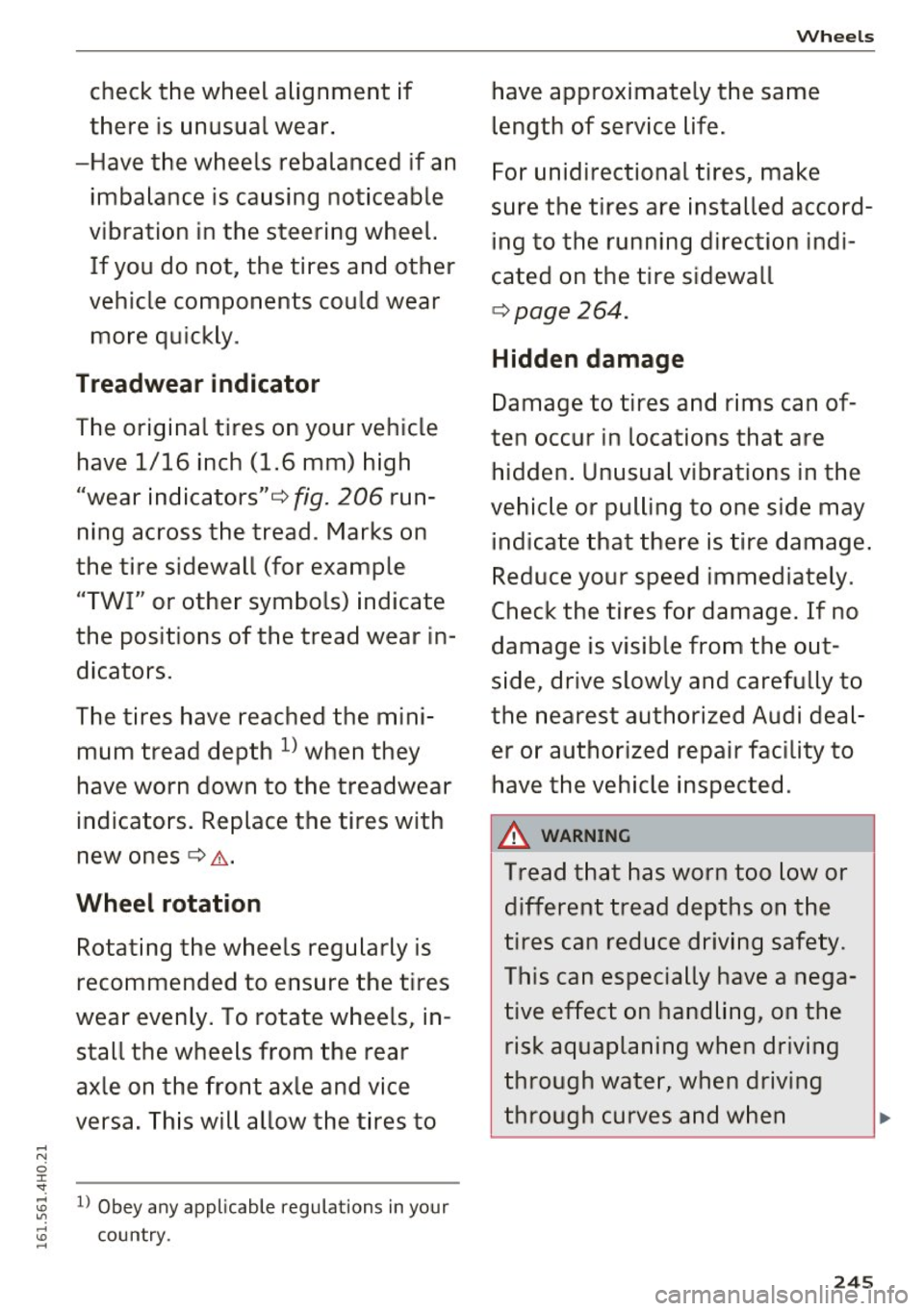
Wheels
check the wheel alignment if have approximately the same
there is unusual wear. length of service life.
-Have the wheels rebalanced if an
For unidirectional tires, make
imbalance is causing noticeable
sure the tires are installed accord-
vibration in the steering wheel. ing to the running direction indi-
If you do not, the tires and other cated on the tire sidewall
vehicle components could wear
¢ page 264.
more quickly.
Hidden damage
Treadwear indicator
Damage to tires and rims can of-
The original tires on your vehicle ten occur in locations that are
have 1/16 inch (1.6 mm) high hidden. Unusual vibrations in the
"wear indicators" ¢
fig. 206 run-
vehicle or pulling to one side may
ning across the tread . Marks on
indicate that there is tire damage.
the tire sidewall (for example Reduce your speed immediately.
"TWI" or other symbols) indicate
Check the tires for damage. If no
the positions of the tread wear in- damage is visible from the out-
dicators. side, drive slowly and carefully to
The tires have reached the mini- the nearest authorized Audi deal-
mum tread depth
l) when they er or authorized
repair facility to
have worn down to the treadwear have the vehicle inspected
.
indicators. Replace the tires with
_& WARNING
new ones ¢&. -
Tread that has worn too low or
Wheel rotation different tread depths on the
Rotating the wheels regularly is tires can reduce driving safety.
recommended to ensure the tires This
can especially have a nega-
wear evenly. To rotate wheels, in- tive effect on handling, on the
stall the wheels from the rear risk aquaplaning when driving
axle on the front axle and vice through water, when driving
versa. This will allow the tires to through curves and when
..
.... N ci :c ": .... l) Obey
any applicable regulations in your '° "? .... country. '° ....
245